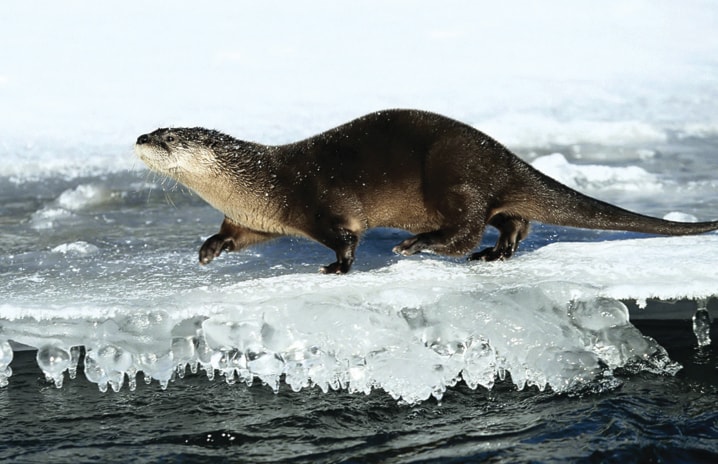Preliminary findings from an Alberta Environment study show that the otter population in the West Country is seemingly low and sustainable.
Concerns from anglers around Rocky Mountain House over recent years about the health of the sport fisheries sparked a two-year research project into what many thought was a growing otter problem.
Fish are alleged to be one of the main items on an otter’s diet list after all.
However, since Carrie Nugent, a wildlife biologist with Alberta Environment and based in Drayton Valley, began the hunt for more data collection on the West Country otters in September 2011, she spotted only one otter.
“We saw one otter . . . It was around Nordegg and for the amount of time spent in the field, that is a really low number. I was just as surprised as anyone about that,” Nugent said.
“We looked for tracks, scats and just found not a lot of signs.
“So at this point I would say the otter population is at a really low density as it was difficult to detect them, despite targeting areas where we thought they would be most active.”
Without some sort of sample size, it’s impossible to create a population estimate, she added.
While it is known there are otters living at Cow Lake, Nugent focused on streams to find out more about the river creatures and the fisheries.
Her team researched at least 20 different streams, honing in on about 1-km sections where “prey availability” would also be escalated due to high fish density.
She also spent a large amount of time at Prairie Creek during the brown trout spawning season (October and November).
“This was an area that many anglers were specifically concerned about and if there was an otter effect, we were going to detect it over spawning or wintering,” Nugent said.
“I walked that area every week for six weeks throughout the season and didn’t find a single track, scat, no sign of an otter there.”
While it’s not a “fully conclusive study,” the fact that there were no signs of otters during a time when fish are most vulnerable, led the researchers to believe the otters may not be as big of an issue as originally thought.
Something Nugent did notice was the state of the surrounding habitat.
“I was shocked at the habitat’s state on the Prairie Creek spawning grounds. This is where anglers are complaining about decreasing catch and I thought I would be walking around a mainly undisturbed area but it’s on private land largely and there are a lot of areas where cows, horses and ATVs are in the river,” she said.
“I found one area where there was obvious illegal harvesting going on, some poaching.”
It’s key to look at the “big picture” when looking at issues with the fisheries, Nugent said.
“Anglers are aware of a lot of the challenges that the fish face and are concerned that otter mortality is one more pressure on the population but whether otters are the real driver behind the complaints we’re receiving about fisheries,
“I couldn’t say. I doubt it based on what I saw.”
Nugent is now in the middle of another analysis based on otter fur harvest data from trappers.
“I have fur harvest records back to the 80s and 90s,” she said.
“I have completed a preliminary spatial analysis looking at the harvest density across the whole province. Cold Lake has the highest harvest density — we know that’s an area with historically a higher otter population.
“In the West Country most of the areas have a quota of zero. In some the quota is of one.”
She discovered the number of otters trapped in each WMUs (Wildlife Management Units or zones that divide up the province primarily for hunting purposes) in the West Country over a five-year period average out to about one.
From 2003 to 2008, she found an average of 0.4 otters were trapped per trapline in one WMU, where there are about three to four traplines, Nugent said.
The total number of otters trapped from 1985 to 2008 is 13 in another West Country WMU, 338 (in the middle of Edmonton and Jasper), and 14 in WMU 330 (covering just north of Rocky Mountain House to just south of Drayton Valley).
“Overall, it’s a really low harvest,” she said.
Nugent’s final report on what she found on otters in the West Country should be ready by February.
It is not yet known if it will be made available to the public.
“I am continuing to do a little bit of investigating over the winter at stocked trout ponds that are aerated, looking for signs or tracks of otters being active. It’s an ongoing interest of mine,” Nugent said.
rfrancoeur@www.reddeeradvocate.com
